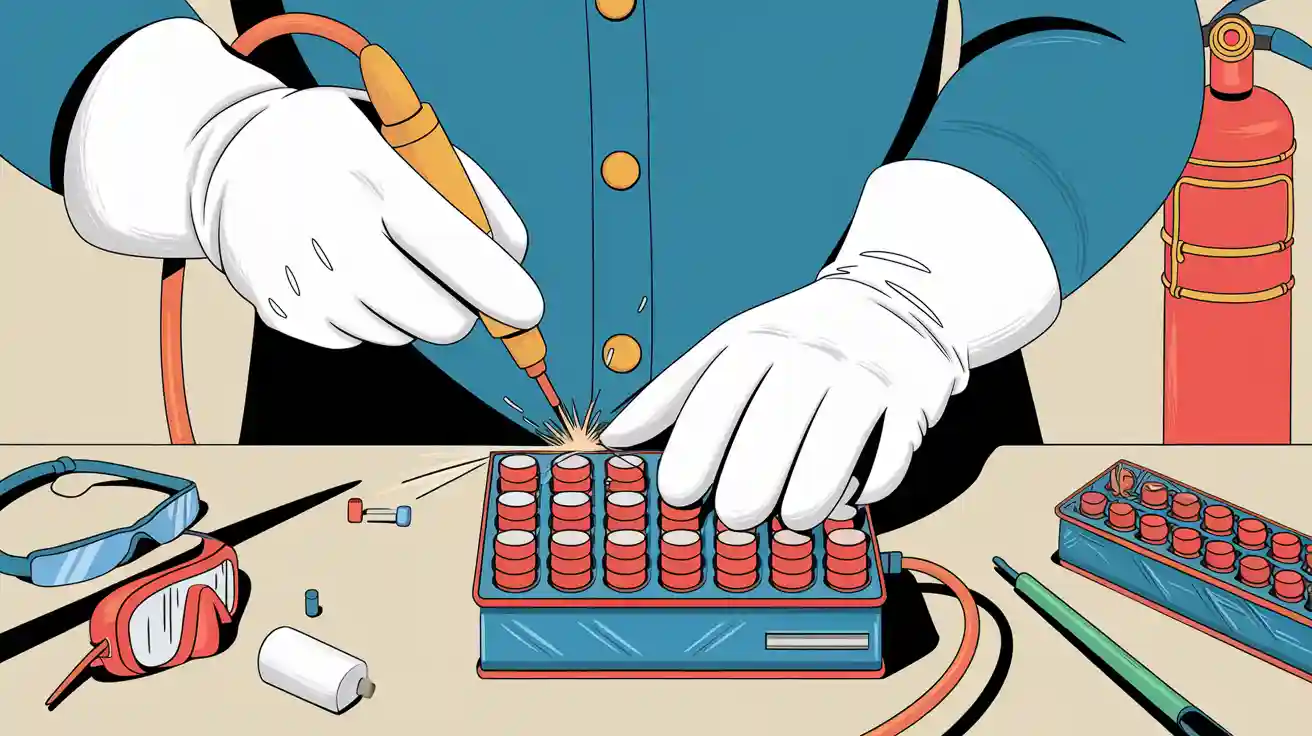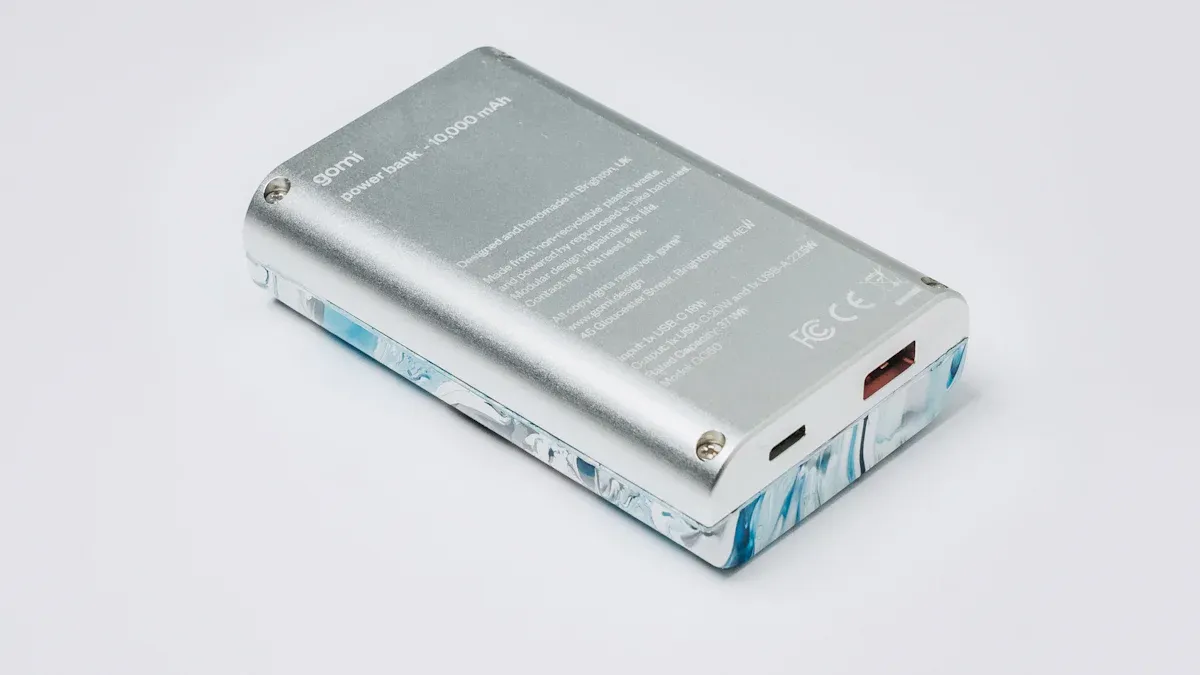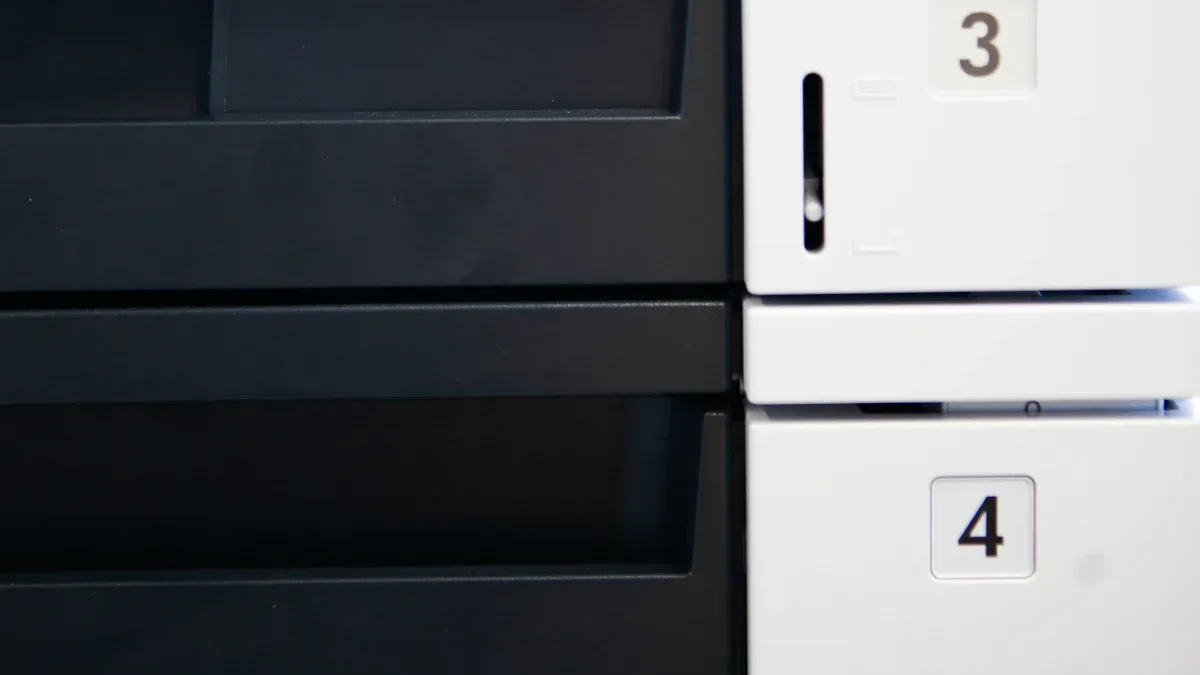
Spot welding is a crucial aspect of battery technology, particularly when learning how to spot weld lithium batteries for assembling reliable battery packs. This precise technique is essential for creating strong and durable connections between nickel strips and battery terminals. However, understanding how to spot weld lithium batteries correctly is vital to avoid safety hazards like overheating, fire, or damage to the batteries. By prioritizing precision and safety throughout the process, you can ensure both the reliability of the battery pack and your own protection during the procedure.
Key Takeaways
Spot welding is important for making strong links in lithium batteries. It reduces heat effects, keeping the cells safe and working well.
Using good tools and taking care of them improves weld quality. Regular care and training for workers are key for best results.
Safety gear is a must when spot welding. Always wear safety clothes, gloves, and a welding helmet to stay safe and avoid injuries.
Part 1: Understanding Battery Spot Welding
1.1 What Is Spot Welding in Battery Technology?
Spot welding is a specialized technique used to join two or more metal surfaces by applying heat and pressure at specific points. In battery technology, this method is essential for creating secure connections between nickel strips and battery terminals. The process involves using a spot welder to generate a high current that melts the metal surfaces, forming a strong bond upon cooling. This ensures that the welds are both durable and conductive, which is critical for the efficient operation of lithium batteries.
The precision of spot welding makes it ideal for applications requiring minimal thermal impact. Unlike other welding methods, it focuses heat only on the targeted area, reducing the risk of damaging sensitive components within the battery. This precision is particularly important when working with lithium-ion batteries, as their internal chemistry can be highly sensitive to excessive heat.
1.2 Why Spot Welding Is Preferred for Lithium Batteries
Spot welding is the preferred method for assembling lithium batteries due to its efficiency, reliability, and ability to maintain the integrity of the cells. Here are some key reasons why it stands out:
Minimal Heat Impact: Spot welding generates localized heat, preventing damage to the delicate internal structure of lithium-ion cells.
Strong Electrical Connections: The welds created are highly conductive, ensuring efficient energy transfer within the battery pack.
High Precision: Advanced spot welding equipment allows for precise control over the welding process, which is crucial for maintaining consistency across multiple cells.
Scalability: Spot welding machines can handle high production volumes, making them suitable for both small-scale DIY projects and large-scale industrial manufacturing.
The growing demand for lithium batteries in electric vehicles, consumer electronics, and energy storage systems has further solidified the importance of spot welding. According to industry reports, the market for lithium battery spot welding machines was valued at USD 450 million in 2024 and is projected to reach USD 1.2 billion by 2033, with a compound annual growth rate (CAGR) of 12.5% from 2026 to 2033. This growth highlights the increasing reliance on spot welding for battery assembly.
1.3 Applications in Lithium Battery Pack Assembly
Spot welding plays a pivotal role in the assembly of lithium battery packs, ensuring both structural integrity and electrical performance. Its applications span various industries, including automotive, medical, and robotics. Here are some notable examples:
Cylindrical Lithium-Ion Cells: Spot welding is commonly used to connect nickel strips to cylindrical cells, forming the backbone of battery packs for electric vehicles and portable electronics.
High-Precision Welding: Modern spot welding machines feature rotating welding heads and integrated monitoring systems, enabling precise welds and real-time quality feedback. These machines can process up to 4,500 pieces per hour, significantly boosting production efficiency.
Customization: Spot welding equipment can be tailored to accommodate different cell sizes and welding specifications, making it versatile for various applications.
The technical advancements in spot welding technology, such as automated feeding mechanisms and AI integration, have further enhanced its effectiveness. Approximately 15 million units of lithium battery spot welding machines are produced annually, with a high concentration in regions like China and South Korea. These machines are equipped with precision control systems and integrated quality checks, ensuring consistent and reliable welds.
For businesses looking to optimize their battery pack assembly processes, investing in advanced spot welding equipment is a strategic move. You can explore custom battery solutions tailored to your specific needs by visiting Large Power’s custom battery solutions.
Part 2: Tools and Materials for Spot Welding Lithium Batteries

2.1 Essential Equipment for Battery Spot Welding
To achieve reliable welds during spot welding, you need the right equipment. The performance of your tools directly impacts the quality of the connections in lithium batteries. Here are the key performance metrics and expert recommendations for essential equipment:
Performance Metrics:
Welding speed ensures efficiency in production.
Consistency guarantees uniform welds across all battery cells.
Adaptability allows the equipment to handle various battery designs.
Expert Recommendations:
Regularly maintain your spot welder by cleaning electrodes and checking alignment.
Train operators to understand machine functions and troubleshoot issues.
Customize welding parameters based on the specific requirements of lithium battery packs.
Investing in high-quality equipment ensures strong and conductive connections, which are critical for the performance of lithium batteries.
2.2 Selecting the Right Spot Welder for Lithium Batteries
Choosing the right spot welder depends on your application needs. Different types of welders offer unique advantages for lithium battery assembly. The table below compares common options:
Type | Price Range | Best For |
|---|---|---|
Ultrasonic | 15K–40K | Pouch cells |
Laser | 30K–100K | Cylindrical cells |
Resistance | 5K–20K | Busbar welding |
When selecting a welder, consider these factors:
Material Compatibility: Ensure the welder suits the materials, such as aluminum tabs or nickel strips.
Production Volume: Use manual bench welders for small-scale projects and automated lines for mass production.
Precision Needs: Ultrasonic welders are ideal for thin-film welding.
Safety Certifications: Verify compliance with CE, UL, or GB/T standards.
After-Sales Support: Choose a supplier with responsive technical support.
Selecting the right welder ensures precise and durable welds, enhancing the reliability of your lithium battery packs.
2.3 Safety Gear and Protective Measures
Spot welding involves risks, so you must follow safety precautions to protect yourself and maintain a safe workspace. The table below outlines essential safety gear and compliance standards:
Safety Gear | Compliance Standard | Recommendations |
|---|---|---|
Footwear | ASTM F2413-05 | Closed-toed shoes required; leather high-top work boots or metal-toe safety shoes recommended. |
Clothing | N/A | Natural fiber materials (cotton or wool); long-sleeved shirts and long pants required. |
Welding Helmet | ANSI Z49.1 | Helmet with shaded lens recommended based on amperage used during welding. |
Gloves | N/A | Leather welding gloves required; type depends on welding process. |
Respiratory Protection | N/A | Half-mask respirator with P100 filter recommended; consult doctor if respiratory issues exist. |
Always inspect your safety gear before starting. Following these precautions minimizes risks like burns, inhalation of fumes, or eye injuries. Prioritizing safety ensures a secure and efficient spot welding process.
Part 3: Step-by-Step Guide to Spot Welding Lithium Batteries

3.1 Positioning Nickel Strips and Battery Terminals
Proper positioning of nickel strips and battery terminals is the foundation of effective spot welding. Misalignment can lead to weak welds, poor conductivity, or even damage to the lithium batteries. To ensure precision, follow these steps:
Prepare the Workspace: Use a clean, flat surface to prevent contamination. A welding jig can help stabilize the cells during the process.
Align the Nickel Strips: Place the nickel strips over the battery terminals, ensuring they are centered and aligned with the polarity markings. This step is crucial for maintaining strong electrical connections.
Secure the Strips: Use neodymium magnets to hold the nickel strips in place. This prevents movement during welding and ensures consistent results.
The table below provides detailed schematics for selecting the appropriate nickel strip size based on current requirements:
Strip Size | Optimal [A] | Acceptable [A] | Poor [A] |
|---|---|---|---|
0.1mm x 5mm | < 2.1 | 3.0 | > 4.2 |
0.1mm x 7mm | < 3.0 | 4.5 | > 6.0 |
0.15mm x 7mm | < 4.7 | 7.0 | > 9.4 |
0.2mm x 7mm | < 6.4 | 9.6 | > 12.8 |
0.3mm x 7mm | < 10.0 | 15 | > 20.0 |
Tip: For a DIY battery pack, use two 0.3mm nickel strips to handle a maximum battery current of 30A. This ensures strong connections and optimal performance.
3.2 Applying Pressure and Activating the Spot Welder
Applying the correct pressure and activating the spot welder with precision are critical for achieving durable welds. Follow these guidelines to ensure success:
Set the Pressure: Adjust the spot welder’s pressure settings according to the thickness of the nickel strips. For most lithium batteries, a pressure range of 35 PSI to 95 PSI is ideal.
Position the Electrodes: Place the electrodes directly over the nickel strip and battery terminal. Ensure they are perpendicular to the surface to avoid uneven welds.
Activate the Welder: Use a foot pedal or manual trigger to activate the spot welder. Maintain steady pressure throughout the process to create a strong bond.
Note: Consistent pressure and current are essential for preventing overheating and ensuring the longevity of the battery pack.
3.3 Testing Welds for Strength and Consistency
Testing is the final step in the spot welding process. It ensures that the welds are strong, consistent, and capable of handling the required electrical load. Here’s how to perform effective testing:
Visual Inspection: Examine the welds for uniformity. A well-executed weld will have a smooth, circular appearance without visible cracks or gaps.
Pull Test: Gently tug on the nickel strip to verify that it is securely attached to the battery terminal. The strip should not detach under moderate force.
Electrical Testing: Use a multimeter to measure the resistance across the welds. Low resistance indicates strong electrical connections.
The table below summarizes strength test results for various materials:
Material Type | Nugget Diameter (mm) | Nugget Shape Quality |
|---|---|---|
Regular Aluminum | 8 | Well-defined circular |
AM Aluminum (as-is) | 6 | Less circular |
AM Aluminum (600-grit) | 9 | Better circularity |
Regular Stainless Steel | 5 | Well-defined circular |
AM Stainless Steel (as-is) | 4 | Less circular |
AM Stainless Steel (600-grit) | Better circularity |
Tip: Consistent testing not only ensures the reliability of your battery pack but also helps identify potential issues early in the assembly process.
By following these steps, you can master the art of spot welding lithium batteries. Whether you’re working on a DIY battery pack or a large-scale industrial project, precision and testing are key to achieving strong, reliable welds.
Spot welding lithium batteries demands safety and precision to ensure reliable results. You must follow key steps like proper positioning, applying consistent pressure, and testing welds. Use the right tools and protective gear to minimize risks. Adhering to best practices guarantees strong connections and a risk-free battery pack assembly.
FAQ
1. How do you prevent overheating during spot welding?
Overheating can be avoided by using precise pressure settings, maintaining consistent current flow, and ensuring proper alignment of electrodes and nickel strips.
Tip: Use a cooling system or pause between welds to reduce heat buildup. For professional guidance on overheating protection, visit Large Power.
2. Can you spot weld aluminum tabs on lithium batteries?
Yes, but aluminum requires specialized welders like ultrasonic or laser types due to its higher resistance and unique thermal properties.
Note: Verify compatibility with your equipment before welding aluminum.
3. What is the ideal nickel strip thickness for high-current applications?
For currents above 30A, use 0.3mm nickel strips. Thicker strips ensure durability and conductivity for demanding applications.
Current Range (A) | Recommended Strip Thickness |
|---|---|
< 10 | 0.1mm |
10–30 | 0.2mm |
> 30 | 0.3mm |
Alert: Avoid using thinner strips for high currents to prevent overheating or weak connections.




